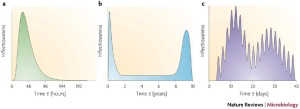Watch John Horgan and Carl Zimmer, preeminent science journalists, gab about Darwin (his birthday was Thursday.) Darwin as Hollywood star, horizontal evolution, rethinking the tree of life, group selection — it’s all good.
As for whether Darwin is overrated, there are a couple ways of looking at it. You can focus on his contemporaries and predecessors, and note that he wasn’t alone in thinking about evolution: there was traveling naturalist Alfred Russel Wallace, whose observations about the geographic distribution of species led him to theorize about the divergence of species, and whose correspondence heavily influenced Darwin’s Origin of Species. The idea that species change over time was advanced by Robert Grant, who saw a progression in fossil animals; Robert Chambers, author of the popular-science bestseller Vestiges of the Natural History of Creation; and Charles’ grandfather Erasmus Darwin, who hypothesized that all life had a common origin. You could argue that Darwin worked in a ferment of ideas about life’s origins and variation, that he was not alone. It’s a useful perspective. Scientists are rarely lone geniuses, even if they are geniuses — they collaborate, borrow, and bicker like everybody else.
Does that make Darwin overrated? I don’t think so. He did, after all, put forward the theory of natural selection as we now know it. Vestiges was a vast, mystical treatment of the origins of the universe (complete with some racial theorizing unsavory to contemporary eyes); Origin was a cautious work, anticipating every counterargument, bolstered with pages of evidence about pigeon breeding. Darwin made evolution a subject of scientific study.
He’s also a profoundly appealing figure. Unlike, say, Newton (combative, paranoid, devoted to his alchemy), Darwin the man was genuinely likeable. He had something of the attitude of the humble, persistent noodler. He measured armadillo fossils in the Galapagos, and thought it was odd that they resembled (but were not identical to) the armadillos his expedition was roasting for dinner over the campfire. He was a rigorous observer, but he also had a useful aimless curiosity. He was an abolitionist and a loving husband and father. We can sympathize with the loss of his daughter and his doubts about the theory of evolution. If we want to put a human face on science, we could do worse than Darwin.






